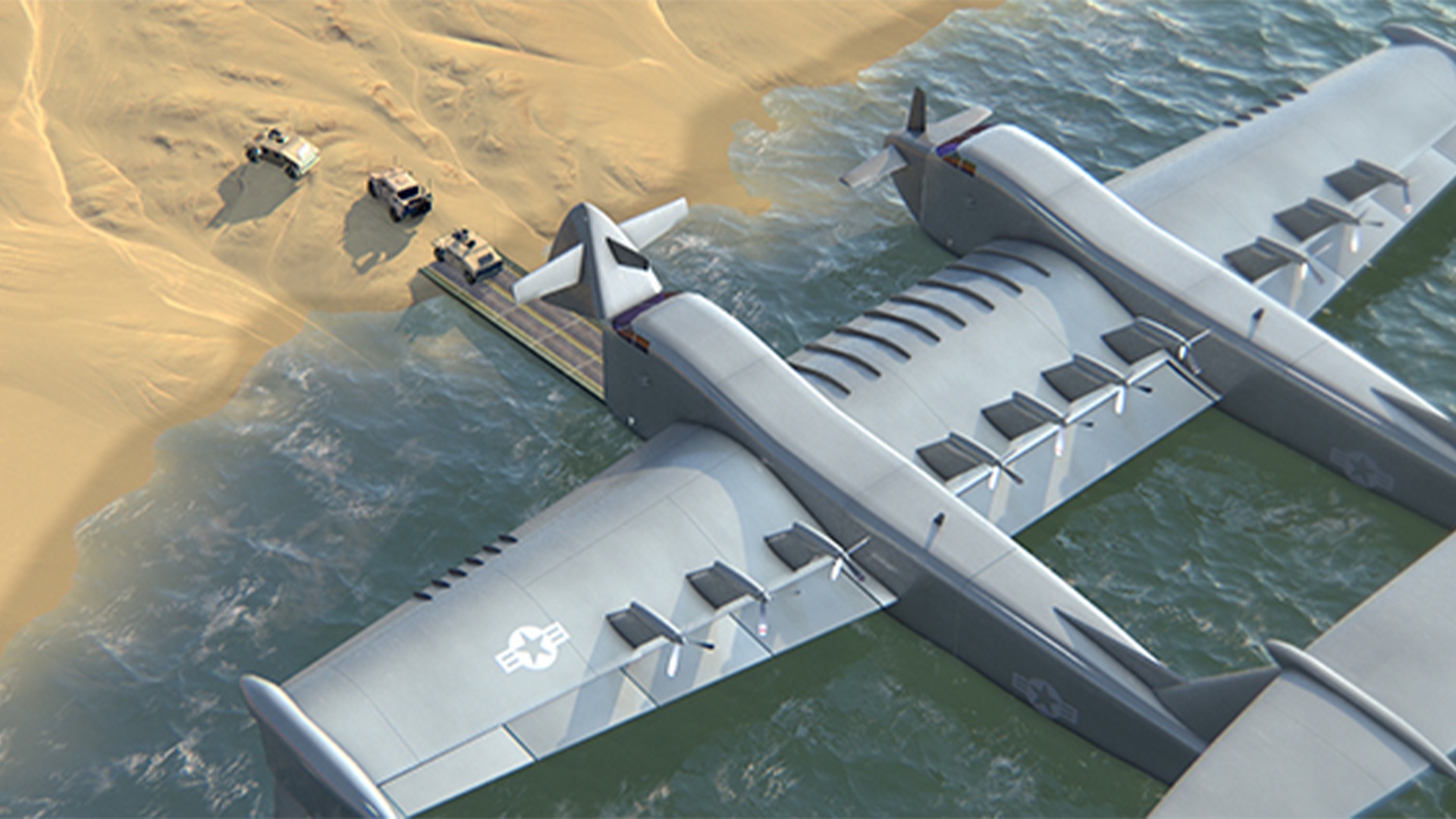

It’s a boat. It’s a plane. It’s both. The Liberty Lifter X-plane is a concept for a ground effect vehicle for “seaborne strategic and tactical heavy lift” according to the Defense Advanced Research Projects Agency (DARPA). Now, two companies — Aurora Flight Sciences and General Atomics — have been selected to build it.
The requirements for the Liberty Lifter call for a plane similar in size and cargo capacity to a C-17 Globemaster III. It’s supposed to be able to take off and land in Sea State 4, which means moderate breezes, wind speeds of 11 to 16 knots and waves of 3 to 5 feet. It’s also supposed to be able to operate on the water in Sea State 5 — with wind speeds ranging from 17 to 21 knots and waves up to 8 feet high. And it’s expected to do all this while both skimming just a few feet above the water and at altitudes up to 10,000 feet above sea level.
In other words, the Pentagon wants an amphibious C-17 that can deliver 170,000 pounds of cargo anywhere there’s a beach.

The first phase of the project encompasses 18 months of design work, along with three additional months of manufacturing and testing reviews.
“We are excited to kick off this program and looking forward to working closely with both performer teams as they mature their point-of-departure design concepts through Phase 1,” said DARPA Liberty Lifter Program Manager Christopher Kent on Feb. 1. “The two teams have taken distinctly different design approaches that will enable us to explore a relatively large design space during Phase 1.”

The General Atomics design concept looks something like an airborne catamaran, or the dual-fuselage F-82 Twin Mustang. It features 12 turboshaft engines in the pusher configuration. The nose of both fuselages opens up to offload the cargo.
Aurora Flight Sciences’ concept looks more like, well, a traditional flying boat plane, with a single fuselage and 8 turboprop engines providing the propulsion.

Both aircraft are supposed to rely on the “ground effect” for their low altitude flight. As an aircraft gets lower to the ground, it forces the air into a vortex beneath the wings, which generates lift and essentially allows the plane to basically float at a very low altitude. Flying that low also greatly increases the range and possible payload of the aircraft.
The ground effect, though, only begins when the plane’s altitude is less than that of the wingspan. If the wingspan of a plane is 100 feet, it needs to have less than 100 feet of altitude for the ground effect to come into play.
This isn’t a new concept, either. The Soviet Union was the largest developer of the “ekranoplan,” large ground-effect aircraft capable of flying at extremely low altitudes which would defeat radar intercept. These included the Beriev VA-14, only one of which actually took to the air in the 1970s, and the massive Lun-class, dubbed the “Caspian Sea Monster.” Only one was ever fully built, entering limited service in 1987, and since the collapse of the Soviet Union it has languished in the ensuing decades exclusively in its boat form, being beached and towed around the Caspian Sea.
Subscribe to Task & Purpose Today. Get the latest military news, entertainment, and gear in your inbox daily.
Of course, the major flaw with operating ground-effect aircraft over the water is that it requires fairly calm seas. All the benefits of flying at such a low altitude are out the window if there are 10-foot waves. The Soviet ekranoplan designs were exclusively ground-effect aircraft, making them confined both by their wingspans and the conditions of the sea.
“The Soviets really showed how not to do this, like a lot of things, right?” Alexander Walan, a DARPA official overseeing the Liberty Lifter program for DARPA told Breaking Defense in 2022.
In theory, though, the Liberty Lifter is supposed to fly extremely close to the water and at altitudes of up to 10,000 feet. An ekranoplan and a flying boat, all in one.
The Liberty Lifter isn’t the only new foray into seaplanes. U.S. Air Force Special Operations Command is also working to develop a C-130 with floats to land and take off on water. The second phase of the Liberty Lifter design project is supposed to begin in 2024, culminating in an actual test aircraft that will take — very lowly — to the skies.
The latest on Task & Purpose
- The Army’s futuristic new goggles actually make soldiers less lethal, Pentagon weapons tester says
- Marines outwitted an AI security camera by hiding in a cardboard box and pretending to be trees
- Watch a German Leopard 2 tank carry a beer and not spill a drop
- The Air Force is moving forward with a replacement for its decades-old long-range radar
- India rolls out mortar-toting camo camels for military parade
Want to write for Task & Purpose? Click here.